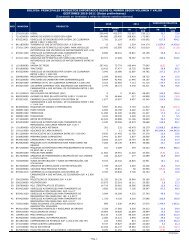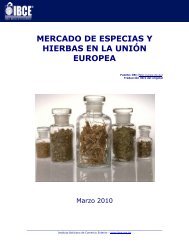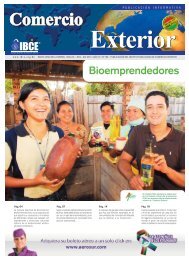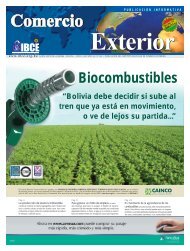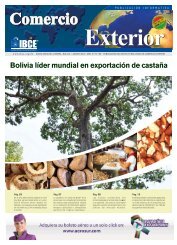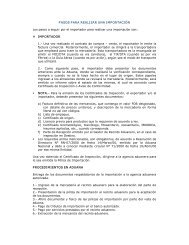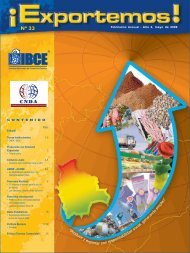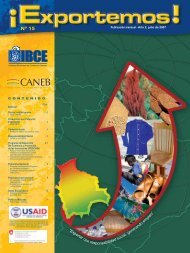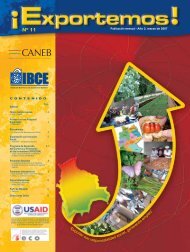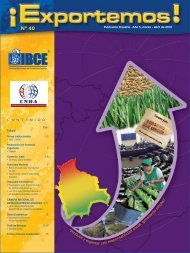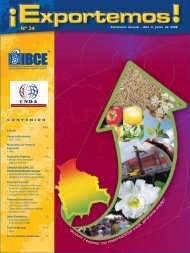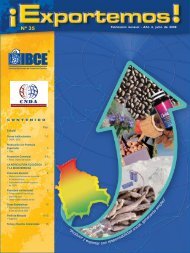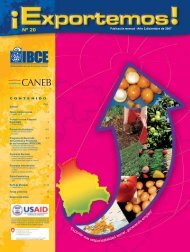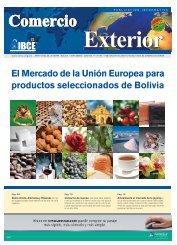The Coffee Exporter's Guide - International Trade Centre
The Coffee Exporter's Guide - International Trade Centre
The Coffee Exporter's Guide - International Trade Centre
- TAGS
- www.ibce.org.bo
Create successful ePaper yourself
Turn your PDF publications into a flip-book with our unique Google optimized e-Paper software.
GRADING AND CLASSIFICATION<br />
Green coffee is graded and classifi ed for export with the<br />
ultimate aim of producing the best cup quality and thereby<br />
securing the highest price. However, there is no universal<br />
grading and classifi cation system – each producing<br />
country has its own, which it may also use to set (minimum)<br />
standards for export.<br />
Grading and classifi cation is usually based on some of the<br />
following criteria:<br />
� Altitude and/or region;<br />
� Botanical variety;<br />
� Preparation (wet or dry process = washed or natural);<br />
� Bean size (screen size), sometimes also bean shape and<br />
colour;<br />
� Number of defects (imperfections);<br />
� Roast appearance and cup quality (fl avour,<br />
characteristics, cleanliness, etc.);<br />
� Density of the beans.<br />
Most grading and classifi cation systems include (often<br />
very detailed) criteria, e.g. regarding permissible defects,<br />
which are not listed here. <strong>The</strong> Origins Encyclopaedia at<br />
www.supremo.be is an example of a website which gives<br />
information on the export classifi cation of coffees of most<br />
origins. Terminology on size and defects as used for<br />
classifi cations is also found at www.coffeeresearch.org.<br />
<strong>The</strong> diversifi ed classifi cation terminology used in the trade<br />
is illustrated with a few examples below. It should be noted<br />
that descriptions such as ‘European preparation’ may differ<br />
from one country to another. <strong>The</strong> examples refer primarily to<br />
the trade in mainstream coffee and do not refl ect the often<br />
more detailed descriptions used for niche markets.<br />
Brazil/Santos NY 2/3<br />
Screen 17/18, fi ne roast, strictly soft, fi ne cup.<br />
Brazil/Santos NY 3/4<br />
Screen 14/16, good roast, strictly soft, good cup (often<br />
seen quoted as ‘Swedish preparation’).<br />
Colombia Supremo screen 17/18<br />
High grade type of washed arabica, screen 17 with<br />
maximum 5% below. Often specifi ed with further details.<br />
Côte d’Ivoire (Ivory Coast) Robusta Grade 2<br />
Grade 2; scale is from 0 (best) to 4 based on screen size<br />
and defects.<br />
El Salvador SHG EP<br />
Strictly High Grown (above 1,200 m; High Grown from<br />
900–1,200 m and Central Standard from 500–900 m).<br />
Commonly used quality descriptions are European<br />
CHAPTER 1 – WORLD COFFEE TRADE – AN OVERVIEW 5<br />
Preparation (maximum 6 defects per 300 g) and American<br />
Preparation (maximum 12 defects per 300 g).<br />
Ethiopia Jimma 5<br />
Sun-dried (i.e. natural) arabica from the Jimma region.<br />
Type 5 refers to a grading scale based on screen, defect<br />
count and cup quality.<br />
Guatemala SHB EP Huehuetenango<br />
Strictly Hard Bean is from above 1,400 m. Scale includes<br />
fi ve altitude levels from below 900 m (Prime washed) to<br />
above 1,400 m. European preparation: above screen<br />
15, allows maximum 8 defects per 300 g (American<br />
preparation: above screen 14, allows 23 defects).<br />
India Arabica Plantation A<br />
Washed arabica, screen 17. Classifi cation is PB, A, B<br />
and C. Other classifi cations apply to unwashed (naturals)<br />
and robusta.<br />
Indonesia Robusta Grade 4<br />
<strong>The</strong> export grade scale goes from 0 (best) to 6. Grade<br />
4 allows 45–80 defects. Region or other details are<br />
sometimes specifi ed as quality, e.g. EK-1 and EK-Special.<br />
Processing depends on the region (island).<br />
Kenya AB FAQ even roast clean cup<br />
Kenya arabica grade AB, fair average quality. Internal<br />
grading system (E, AA, AB, PB, C, TT and T) is based on<br />
bean size and density, further detailed by liquor quality<br />
into 10 classifi cations. Top cupping coffees are mostly<br />
sold on actual sample basis.<br />
Mexico Prime Washed Europrep<br />
Prime Washed (prima lavado) from altitude between<br />
600 m and 900 m, on a scale from 400 m to 1,400 m;<br />
Europrep is retained by screen 17 and allows maximum<br />
15 defects per 300 g.<br />
Papua New Guinea (PNG) Smallholder Y1-grade<br />
Y1 is one of the grades on a scale covering bean size,<br />
defect count, colour, odour, roast aspects and cup<br />
quality; AA, A, AB, B, C, PB, X, E, PSC, Y1, Y2 and T.<br />
Viet Nam Robusta Grade 2 maximum 5% blacks and<br />
broken<br />
Grade 2 out of six grades: Special Grade and Grade 1<br />
to 5, based on screen size and defects. (Descriptions<br />
are often supplemented with further details on moisture<br />
content, acceptable mix of bean types, bean size, etc.)



